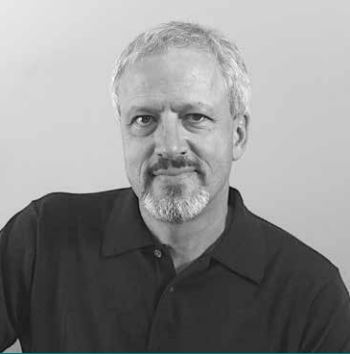Framing the Future: Addressing New Mexico’s Myths and Truths

Exhibition designer John Chiodo helped develop the
New Mexico History Museum’s Framework for the
Future. Photo courtesy John Chiodo.
New Mexicans take pride in their rich, diverse history, celebrating connections to land, food and family while wrestling with such darker legacies as colonization and atomic power.
State history is also a source of interest for visitors, many of whom come to the New Mexico History Museum to learn and engage. Located just off the Santa Fe Plaza, the museum campus contains the historic Palace of the Governors, a museum building on Lincoln Avenue, a research library and photography archive.
But telling New Mexico history is a difficult task. Too often the museum has reinforced the tourist-friendly myth of a tricultural Santa Fe—with Native peoples, Hispanos and Anglos living “in harmony” in the country’s oldest capital city. This myth not only dismisses the longtime contributions of other cultures in the city’s history, it glosses over the complex relationships among the cultures who call the region home.
As museums everywhere shift to more inclusive storytelling models, New Mexicans are clamoring for more from their history museum. They want a more vibrant museum experience, with exhibitions that engage the senses. They want stories from around the state that explode myths, explore lesser-known communities and cover different time periods. And they want to help tell
those stories.
“The museum recognized that there were gaps in what it was doing, and they needed a better understanding of how the museum was operating and could better serve New Mexicans,” says John Chiodo, an internationally known exhibition designer who helps museums develop contemporary storytelling models. “To do that, we had to open up the doors and pull in input about what the museum should be doing.”
Chiodo worked at the museum with Gail Anderson, a consultant in organizational transformation, to develop what they’re calling a Framework for the Future. Though both have worked with national and international museums and educational institutions, Anderson and Chiodo live in Santa Fe and bring their vast expertise to this crucial project in their hometown.
“Telling the many truths that make up our state, in the voices of our state, is so powerful,” Anderson says. “I think it will engender greater interest in our history, instead of promoting old ideas.”
Throughout 2023, the consultants met weekly with a staff steering committee, led by museum executive director Billy Garrett and deputy director Catherine Trujillo. Beginning in June, they held four virtual workshops with a statewide planning committee, culminating in a fifth and final in-person session in December. The committee was comprised of experts in their fields, including Porter Swentzell, head of education at Santa Clara Pueblo; Nikki Nojima Louis from the New Mexico Japanese American Citizen League; and Chris Wilson, University of New Mexico professor emeritus and author of The Myth of Santa Fe: Creating a Modern Regional Tradition. As part of this process, the museum also issued a public survey completed by more than 700 people statewide.
Improving accessibility is a key part of Framework for the Future. Museums often rely on purely visual mediums like photography and wall text, which isn’t especially fulfilling for people with visual impairments or those who simply learn better when information is delivered differently, says planning committee member Greg Trapp, executive director of the New Mexico Commission for the Blind. “You can have an app or a button that you push, and you can listen to a description of that panel. Museums that I especially enjoy offer a greater tactile experience. Certainly not all exhibits permit that, but there are ways to have narrative that make the experience more interesting.”
Although bandwidth issues in rural areas of New Mexico limit how people experience the internet, online exhibitions and programs are also vital to accessibility initiatives. Traveling exhibitions are another way to bring the museum to the people, especially school groups that can’t take field trips to Santa Fe.
The goal of the Framework process was the development of a living document that can be refined over time. Change doesn’t happen overnight, the consultants say, and the goal is not to slap a shiny bandage on a systemic problem.
“The workshops were like a series of stepping stones. In between, we reported to the steering committee to discuss our findings and formulate how we wanted to present subsequent workshops,” Chiodo explains.
The result is not a list of exhibitions or a diversity checklist, but a strategy for the museum to use when planning exhibitions and public programming, and when building relationships with communities and other institutions around the state.
“In this process, you’re moving an embedded, centuries-deep style of museums to the 21st century. You’re thinking completely differently about your role as a museum, about your community and the public’s involvement,” Anderson says. “Quick solutions get stuck on the shelf when they don’t work. Framework for the Future allows the New Mexico History Museum to try new things, learn from their mistakes, and then try again.”
This article and image are from the Museum of New Mexico Foundation’s Member News Magazine.


Connect